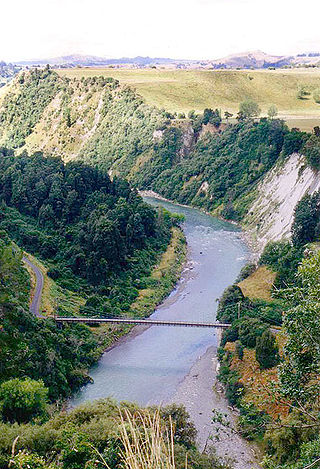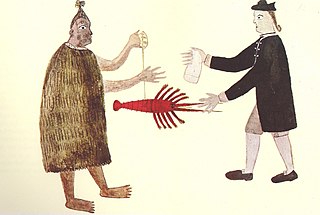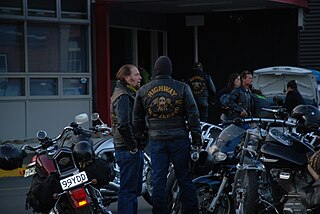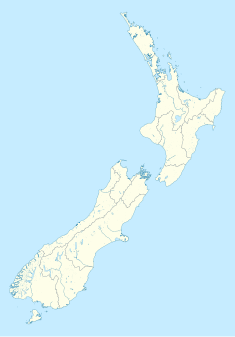
Taranaki is a region in the west of New Zealand's North Island. It is named after its main geographical feature, the stratovolcano Mount Taranaki, also known as Mount Egmont.

Riwha Tītokowaru was a Taranaki Māori rangatira, military commander, general and religious leader. He is considered to be one of the most capable and influential military strategists in New Zealand history. He waged a war against invading settlers and Crown forces which became known as Tītokowaru's War. His reputation has stayed largely the same for 150 years; James Belich has described him as "perhaps the greatest war leader either of New Zealand’s peoples has ever produced".

The New Zealand Wars took place from 1845 to 1872 between the New Zealand colonial government and allied Māori on one side, and Māori and Māori-allied settlers on the other. Though the wars were initially localised conflicts triggered by tensions over disputed land purchases, they escalated dramatically from 1860 as the government became convinced it was facing united Māori resistance to further land sales and a refusal to acknowledge Crown sovereignty. The colonial government summoned thousands of British troops to mount major campaigns to overpower the Kīngitanga movement and also conquest of farming and residential land for British settlers. Later campaigns were aimed at quashing the Pai Mārire religious and political movement, which was strongly opposed to the conquest of Māori land and eager to strengthen Māori identity. Māori religious movements that promoted pan-Māori identity played a major role in the Wars.
The Second Taranaki War is a term used by some historians for the period of hostilities between Māori and the New Zealand Government in the Taranaki district of New Zealand between 1863 and 1866. The term is avoided by some historians, who either describe the conflicts as merely a series of West Coast campaigns that took place between the Taranaki War (1860–1861) and Titokowaru's War (1868–69), or an extension of the First Taranaki War.

Tītokowaru's War was a military conflict that took place in the South Taranaki region of New Zealand's North Island from June 1868 to March 1869 between the Ngāti Ruanui and Ngāruahine Māori tribes and the New Zealand Government. The conflict, near the conclusion of the New Zealand wars, was a revival of hostilities of the Second Taranaki War as Riwha Tītokowaru, chief of Ngaruahine, responded to the continued surveying and settlement of confiscated land with well-planned and effective attacks on settlers and government troops in an effort to block the occupation of Māori land.

Whanganui, also spelt Wanganui, is a city in the Manawatū-Whanganui region of New Zealand. The city is located on the west coast of the North Island at the mouth of the Whanganui River, New Zealand's longest navigable waterway. Whanganui is the 19th most-populous urban area in New Zealand and the second-most-populous in Manawatū-Whanganui, with a population of 42,500 as of June 2024.

The Rangitīkei River is one of New Zealand's longest rivers, 253 kilometres (157 mi) long.

Cape Foulwind is a headland on the West Coast of the South Island of New Zealand, overlooking the Tasman Sea. It is located 11 kilometres (6.8 mi) west of the town of Westport. There is a lighthouse located on a prominent site on the headland. A walkway beginning at the lighthouse carpark traverses the rocky headland to Tauranga Bay and passes close by a colony of New Zealand fur seals. There is limestone quarry in the area, and a cement works operated nearby from 1958 to 2016.

James Christopher Belich is a New Zealand historian, known for his work on the New Zealand Wars and on New Zealand history more generally. One of his major works on the 19th-century clash between Māori and Pākehā, the revisionist study The New Zealand Wars (1986), was also published in an American edition and adapted into a television series and DVD.

Blockhouse Bay is a residential suburb in the south west of Auckland, in New Zealand's North Island. It is sited on the northern coast of the Manukau Harbour, and is also close to the administrative boundary that existed between Auckland City and Waitakere City, two of the former four cities of what was the Auckland conurbation before amalgamation into Auckland Council.

Whanganui Collegiate School is a state-integrated, coeducational, day and boarding, secondary school in Whanganui, Manawatū-Whanganui region, New Zealand. The school is affiliated to the Anglican church.

The Whanganui River is a major river in the North Island of New Zealand. It is the country's third-longest river, and has special status owing to its importance to the region's Māori people. In March 2017 it became the world's second natural resource to be given its own legal identity, with the rights, duties and liabilities of a legal person. The Whanganui Treaty settlement brought the longest-running litigation in New Zealand history to an end.

The military history of New Zealand is an aspect of the history of New Zealand that spans several hundred years. When first settled by Māori almost a millennium ago, there was much land and resources, but war began to break out as the country's carrying capacity was approached. Initially being fought with close-range weapons of wood and stone, this continued on and off until Europeans arrived, bringing with them new weapons such as muskets. Colonisation by Britain led to the New Zealand Wars in the 19th century in which settler and imperial troops and their Māori allies fought against other Māori and a handful of Pākehā. In the first half of the 20th century, New Zealanders of all races fought alongside Britain in the Boer War and both World Wars. In the second half of the century and into this century the New Zealand Defence Force has provided token assistance to the United States in several conflicts. New Zealand has also contributed troops extensively to multilateral peacekeeping operations.
The following lists events that happened during 1950 in New Zealand.
The following lists events that happened during 1964 in New Zealand.
The following lists events that happened during 1949 in New Zealand.

The Upper Hutt Blockhouse also known as the Wallaceville Blockhouse is a 19th-century American-style military blockhouse situated in Upper Hutt, New Zealand. One of very few such blockhouses built in New Zealand, it is preserved as a Category I historic place. It was built in late 1860 as part of a larger Stockade and was one of two Blockhouses and Stockades built in the Hutt Valley that year. It was occupied by the Hutt Battalion of the Wellington Militia from December 1860 to May 1861 without coming under hostile attack.

A gang patch in New Zealand refers to the identifying insignia of a street gang. Patches have been linked to intimidation of members of the public by gang members. Gang patches perform much the same identification role as gang colours do in other countries.

Catherine Cheatley is a retired New Zealand professional road and track cyclist. She won two New Zealand championship titles in both road race and individual track pursuit, and later represented her nation New Zealand at the 2008 Summer Olympics. Before her official retirement in June 2012 because of sustained bike crash-related injuries, Cheatley moved to the United States to race for the Cheerwine and Colavita–Sutter Home pro cycling teams in the women's elite professional events on the UCI Women's World Cup, and UCI World Championships, where she earned the bronze medal for the women's points race in 2007.
Marian Maguire is a lithographer from New Zealand. She is known for juxtaposing landscapes, historical characters, and mythical figures from New Zealand and from ancient Greece, mixing the realism of 19th-century colonial prints with the more stylized designs of Greek black-figure pottery and Māori wood carvings.
















